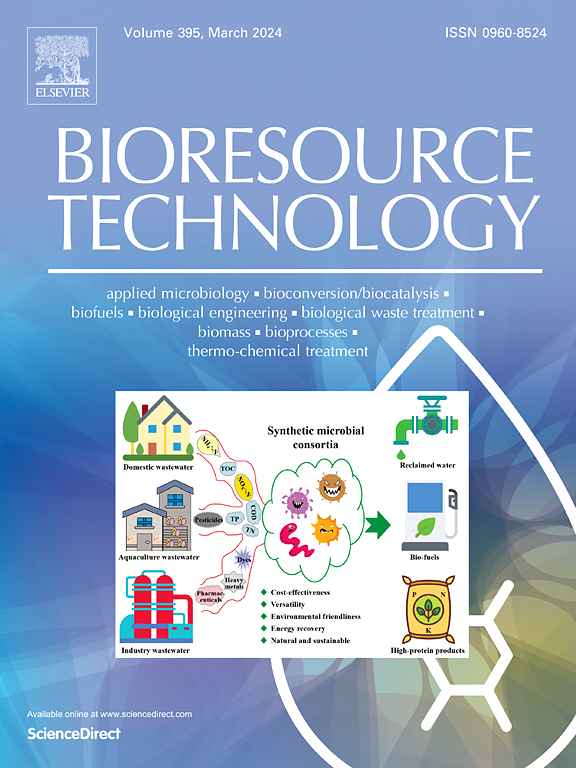Sustainable recycling of animals rendering waste oil into biodiesel via lipase stabilized in ordered-structured large-pore mesoporous silica derived from rice husk
IF 9.7
1区 环境科学与生态学
Q1 AGRICULTURAL ENGINEERING
引用次数: 0
Abstract
The disposal of animal rendering waste oil presents substantial environmental challenges, highlighting the need for efficient and sustainable repurposing strategies. This study reports a pioneering enzymatic approach for converting animal rendering waste oil into biodiesel, representing the first reported application of this method. Furthermore, this is the first study to use ordered, structured large-pore mesoporous silica derived from rice husks (OLMS-RH) as an enzyme support, with a ship-in-a-bottle strategy to increase the enzyme stability, reusability, and catalytic efficiency. The immobilized lipase (LP@OLMS-RH) exhibited a 3.91-fold increase in specific activity and marked thermal and pH stability, and retained its performance for nine reaction cycles and 100 days of storage. Under optimized conditions, LP@OLMS-RH achieved a maximum biodiesel yield of 97.0 % within 7 h, significantly surpassing the 61.7 % yield obtained using free lipase. These enhancements were attributed to hyperactivation of the immobilized enzyme, improved substrate accessibility, and tailored microenvironment provided by the OLMS-RH. This study established OLMS-RH as a highly effective enzyme immobilization platform, enabling the development of a durable and reusable catalytic system for biodiesel production. This approach offers a scalable and environmentally sustainable solution to global waste management challenges by simultaneously improving enzyme performance and facilitating waste oil recycling.

通过由稻壳衍生的有序结构大孔介孔二氧化硅稳定的脂肪酶,可持续地回收动物将废油转化为生物柴油
动物提炼废油的处理带来了巨大的环境挑战,突出了有效和可持续再利用战略的必要性。本研究报告了一种开创性的酶法将动物生产的废油转化为生物柴油,这是该方法首次被报道的应用。此外,这是第一个使用有序的、结构化的来自稻壳的大孔介孔二氧化硅(OLMS-RH)作为酶载体的研究,并采用瓶装策略来提高酶的稳定性、可重复使用性和催化效率。固定化脂肪酶(LP@OLMS-RH)的比活性提高了3.91倍,热稳定性和pH稳定性显著,并在9个反应周期和100天的储存中保持了其性能。在优化条件下,LP@OLMS-RH在7 h内的生物柴油产率达到了97.0%,大大超过了使用游离脂肪酶的61.7%的产率。这些增强归因于固定化酶的过度活化,提高了底物的可及性,以及OLMS-RH提供的定制微环境。本研究建立了OLMS-RH作为高效酶固定化平台,为生物柴油生产提供了一种耐用且可重复使用的催化系统。这种方法通过同时提高酶的性能和促进废油回收,为全球废物管理挑战提供了一种可扩展和环境可持续的解决方案。
本文章由计算机程序翻译,如有差异,请以英文原文为准。
求助全文
约1分钟内获得全文
求助全文
来源期刊

Bioresource Technology
工程技术-能源与燃料
CiteScore
20.80
自引率
19.30%
发文量
2013
审稿时长
12 days
期刊介绍:
Bioresource Technology publishes original articles, review articles, case studies, and short communications covering the fundamentals, applications, and management of bioresource technology. The journal seeks to advance and disseminate knowledge across various areas related to biomass, biological waste treatment, bioenergy, biotransformations, bioresource systems analysis, and associated conversion or production technologies.
Topics include:
• Biofuels: liquid and gaseous biofuels production, modeling and economics
• Bioprocesses and bioproducts: biocatalysis and fermentations
• Biomass and feedstocks utilization: bioconversion of agro-industrial residues
• Environmental protection: biological waste treatment
• Thermochemical conversion of biomass: combustion, pyrolysis, gasification, catalysis.
 求助内容:
求助内容: 应助结果提醒方式:
应助结果提醒方式:


